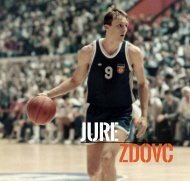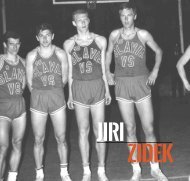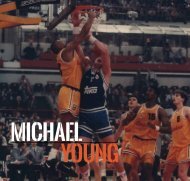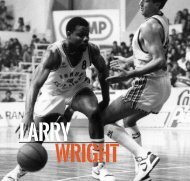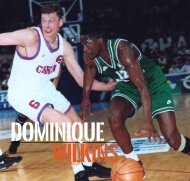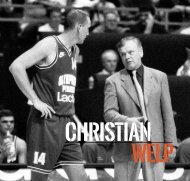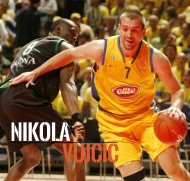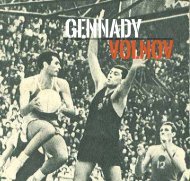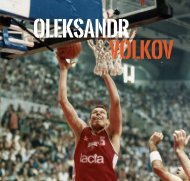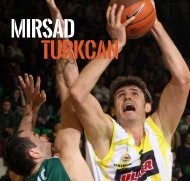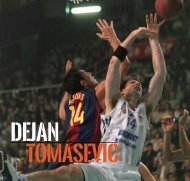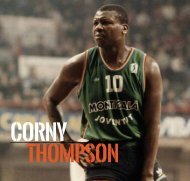101 Greats of European Basketball
You also want an ePaper? Increase the reach of your titles
YUMPU automatically turns print PDFs into web optimized ePapers that Google loves.
Vladimir Stankovic<br />
Lokomotiva wanted to sign both, but Jugoplastika <strong>of</strong>fered<br />
Solman terms that the Zagreb club could not match,<br />
and therefore he went to Split. (That’s why he’s not on my<br />
Zagreb list, because he played most <strong>of</strong> his career in Split).<br />
Plecas decided to accept Lokomotiva’s <strong>of</strong>fer, but Mladost<br />
wouldn’t release his papers. He had to spend 10 months<br />
without playing, but in the end the federation gave the<br />
green light, and Plecas was registered by Lokomotiva at<br />
noon on July 12, 1967. That same night he made his debut<br />
against Crvena Zvezda. He starred with 26 points. The Yugoslav<br />
League was still played during the summer, then,<br />
but would start to be played in arenas the following year.<br />
Lokomotiva won 106-96 against a strong Crvena Zvezda<br />
team with veterans Vladimir Cvetkovic and Sreten Dragojlovic,<br />
plus youngsters like Ljubodrag Simonovic, Dragan<br />
Kapicic and Dragisa Vucinic. Soon, in the Yugoslav Cup<br />
final, Lokomotiva defeated Olimpija 78-77 for what would<br />
become Plecas’s first big trophy.<br />
Although it was his debut in the league that year,<br />
Plecas was already an established talent. The flawless<br />
scouting service <strong>of</strong> the Yugoslav federation had all the top<br />
talents on file. Solman had made his debut in the national<br />
team in 1964 and Plecas did the same one year later, in<br />
the Balkans championship in Kraljevo, Serbia. Yugoslavia<br />
ended up second despite playing at home because it lost<br />
to Bulgaria. However, Coach Ranko Zeravica had four players<br />
on the team who, only five years later, would be world<br />
champions with him still on the bench. They were Plecas,<br />
Simonovic, Kapicic and Aljosa Zorga. Bogdan Tanjevic, a<br />
future great coach, was also there. Talk about vision.<br />
Zeravica took some youngsters to the 1967 EuroBasket<br />
in Helsinki, but not Plecas, whose debut on the great<br />
international stage was postponed until the 1968 Olympics<br />
in Mexico. He returned from Mexico with a silver<br />
medal around his neck, contributing 9 points per game.<br />
Triumph in Ljubljana<br />
Plecas’s career lasted until the late 1970s, but his<br />
peak came at the 1970 World Cup in Ljubljana. At only<br />
22 years <strong>of</strong> age, he became a world champion with<br />
players like Kreso Cosic, Kapicic, Solman, Zorga and<br />
Simonovic, who was one year younger. In the decisive<br />
game against the United States, a 70-63 victory, Cosic<br />
netted 15 points, Petar Skansi scored 14 and Plecas<br />
had 12 points on 8-<strong>of</strong>-10 free throw shooting. He could<br />
always be identified by his moustache, but the following<br />
day, he honored a bet and shaved it <strong>of</strong>f completely.<br />
The following year, Plecas got a call from Aleksandar<br />
Nikolic, the coach at Ignis Varese, the <strong>European</strong> champ<br />
at the time. The <strong>of</strong>fer was for $60,000 per season to<br />
play at the Italian club, a lot <strong>of</strong> money back then, not at<br />
all comparable to what he was getting at Cibona. But<br />
he could not leave. The regulations <strong>of</strong> the federation<br />
said that players had to be at least 28 years old to play<br />
outside the country.<br />
Plecas played with the national team until 1975. He<br />
won gold medals at the 1973 EuroBasket in Barcelona<br />
(the first for Yugoslavia) and the 1975 EuroBasket in<br />
Belgrade. He had previously one two EuroBasket silver<br />
medals, in Naples in 1969 and in Essen in 1971, then<br />
added a silver at the 1974 World Cup in San Juan.<br />
Plecas also took part in the 1972 Olympics in Munich,<br />
where the team finished fifth. In the meantime, he was<br />
also a starter for his team every year. He broke countless<br />
records – in one game against Partizan, he scored<br />
67 points – and he was the league’s top scorer twice, in<br />
1969-70 (30.9 points per game) and 1974-75 (33.1). In<br />
between, the top scorer for the 1972-73 season was his<br />
friend Damir Solman for Jugoplastika (31.0).<br />
In researching data on Plecas, I found an interesting<br />
figure: between 1957 and 1982 – that’s 25 years – the<br />
268<br />
269



